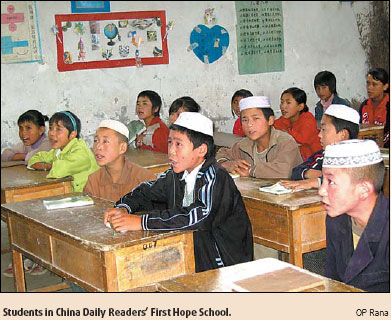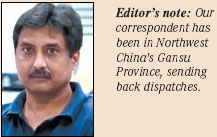Silhouettes of misty mountains, overcast skies, a light drizzle, a well-lit expressway, a Russian song, a bright young colleague and an exceptionally skillful driver for company. Before my colleague Hu Yinan can finish explaining how popular the Russian song was with the Chinese, breaks out a familiar tune. It's Awara hoon, the title song from the 1950s' Indian film Awara, which people throughout the length and breadth of China seem to have fallen in love with when it was screened in the early 1980s. My journey to Dongxiang has begun in earnest.
Dongxiang County in Gansu Province is two and half hours' drive from the capital Lanzhou. It's well past 11pm, and we check into a motel that I was told would be shabby, but turns out to be more than comfortable. Dongxiang is not only the name of the county, but also refers to the ethnic minority, but a majority in the county, and their language. Some prefer Sartans, though.
Next morning, we are off early to China Daily Readers' First Hope School, or Zhouya School, in Pingzhuang Village. Four class rooms, a big compound, a basketball court left slushy by four days of continuous rain, a principal who doubles up as teacher, two teachers (two more have joined since we left late last month on parents' demand), 140 students - that's the school. The village is remote for those who have wandered only around cities. But students trudge there from even remoter places, some taking up to two hours one way.
Autumn may be a full month away, but the chill is already in the air, thanks to the altitude (about 8,000 feet above sea level) and the rain. But nothing can dampen the spirit of the children, for they are in school. And more than the teachers or China Daily readers or for that that matter anybody else, it's their school.
Everyone I referred Dongxiang to before leaving for the place had warned me that it was the "poorest county in the poorest province" of China. I admit it is poor, but poverty means much more to an Indian like me. I've seen it from close, felt, shared and suffered it. I've been to many a school in rural India and seen the kids. They are lively, talkative and mischievous, just like the ones in Zhouya School. But I've always seen melancholy even in their smiling eyes. But the eyes of the Zhouya School kids are different. Their smile is unalloyed. I look for sorrow or despair; can't find any.
And pray to collective consciousness that they lend some of that smile to their Indian brothers and sisters.
(China Daily by OP Rana September 28, 2007)



